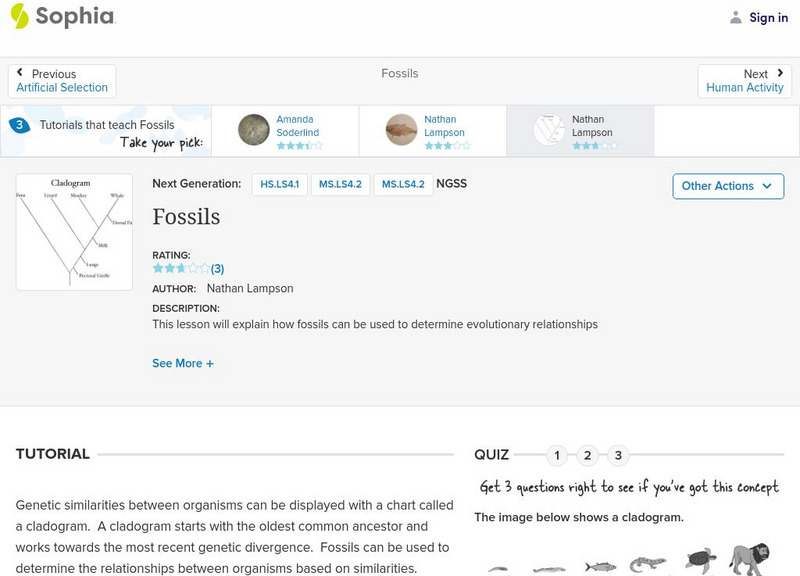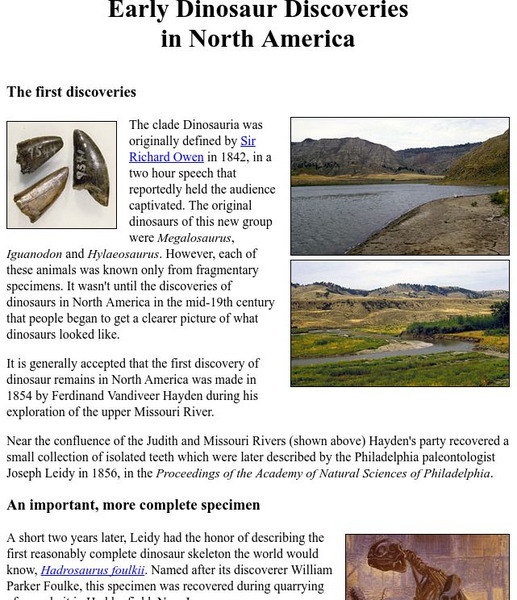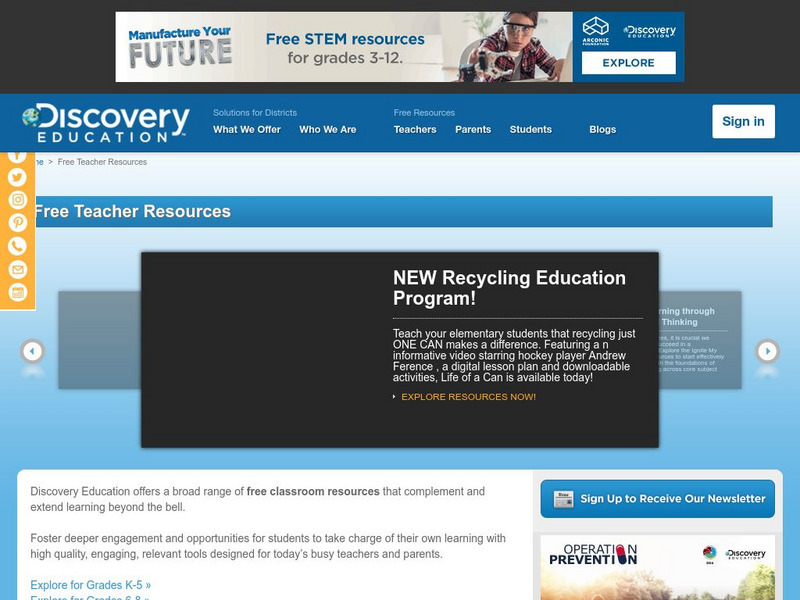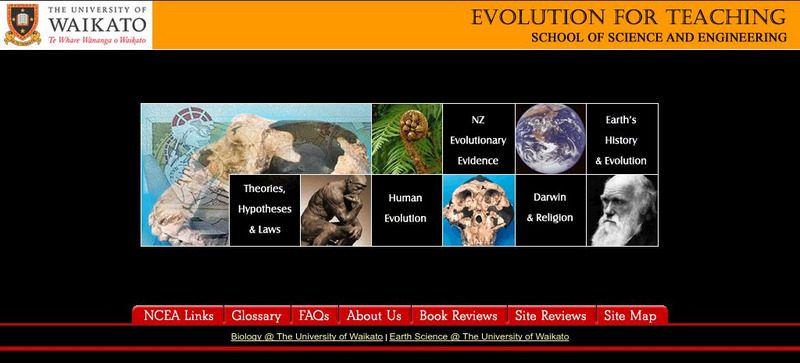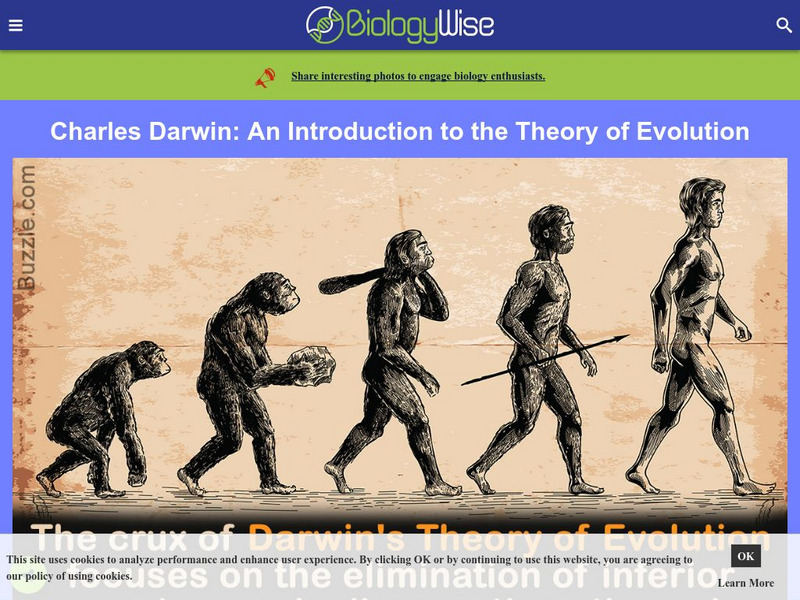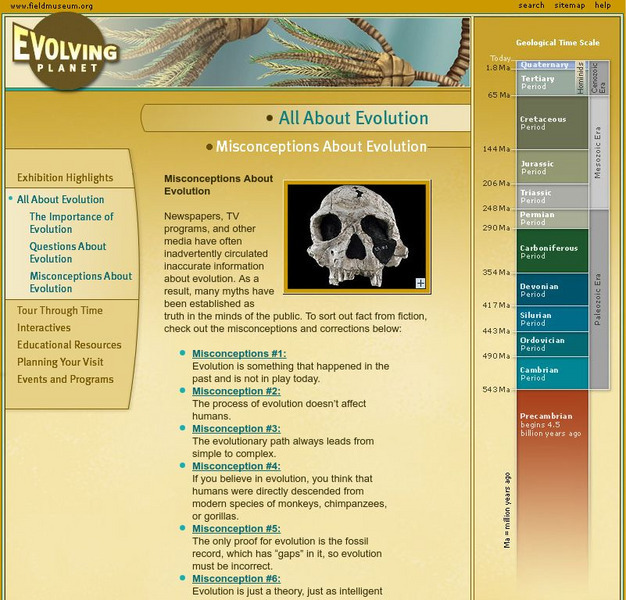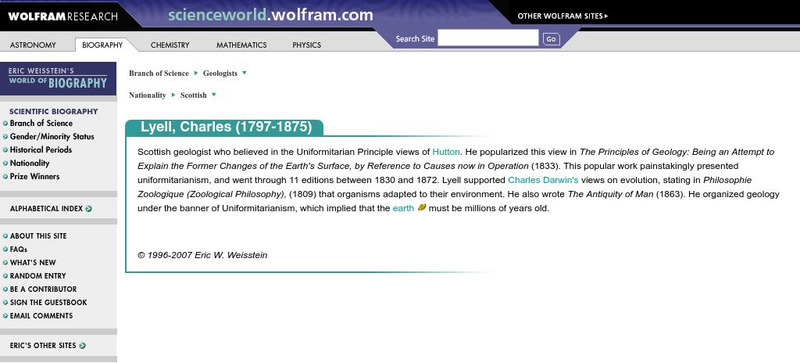Sophia Learning
Sophia: Fossils: Lesson 6
This lesson will explain how fossils can be used to determine evolutionary relationships. It is 6 of 6 in the series titled "Fossils."
University of California
Ucmp: Early Dinosaur Discoveries in North America
This survey of early dinosaur discoveries in North America discusses the first dinosaur specimens and the scientific debate that they inspired.
Other
University of Connecticut: Natural Selection Simulation
This page has a Java simulation that demonstrates allele frequency and natural selection. Choose various numbers for this simulation and run the experiment.
Discovery Education
Discovery Education: Plants
The Discovery Channel provides numerous lesson plans dealing with plants. Content is organized by grade level, but all lesson plans include suggestions for adaptations for older or younger audiences.
Other
The National Museum of Finland
This site gives a brief overview of the museum. Address and phone number are given with links to a little more information.
Discovery Education
Discovery Education: Explore Galapagos
This site provides a fun way of exploring the Galapagos Islands through pictures, sound, videos, games, learning exercises, and more.
The Field Museum
Field Museum: Exhibits: Evolving Planet: All About Evolution
What is evolution? What is natural selection? How has our understanding of evolution changed since Darwin's day? You will find the answers to these questions and more in this basic explanation of the evolutionary process.
Institute and Museum of the History of Science
Institute and Museum of History of Science: Museo Galileo
This site can be viewed in either English or Italian. Many links can take the viewer to more information on the museum.
Enchanted Learning
Enchanted Learning: The Evolution of Mammals
A good and easy to read history of mammals. Relatively brief discussion of the evolutionary history.
Other
Evolution for Teaching: School of Science and Engineering
A reference page containing information related to evolution. Topics discussed on the page is the theories, human evolution, evolutionary evidence, Darwin, and Earth's history.
BiologyWise
Biology Wise: Microevolution vs. Macroevolution
The concepts of microevolution and macroevolution are explained and a two-column table that compares them is presented.
BiologyWise
Biology Wise: Charles Darwin: Introduction to the Theory of Evolution
The main concepts in Charles Darwin's theory of evolution are described, how natural selection works, and the ongoing criticism of evolution from Creationists.
BiologyWise
Biology Wise: Darwin's Theory of Natural Selection
Darwin's theory of natural selection and his ideas about evolution are explained here.
Siteseen
Siteseen: American Historama: Eugenics Movement in America
Interesting facts and information on the Eugenics Movement in America.
Other
Ancestral Flatworms
Gives the history of flatworms and how they evolved. Gives the different types of flatworms, including the tapeworm.
The Field Museum
Field Museum: Exhibits: Evolving Planet: Misconceptions About Evolution
This informative Field Museum exhibit examines seven misconceptions about evolution and provides insight as to why they are incorrect.
The Franklin Institute
The Franklin Institute: Living Things Families
What do centipedes and crabs have in common? What's so special about a backbone? Check this site out from The Franklin Institute if you are interested in biology and classification.
How Stuff Works
How Stuff Works: How Evolution Works
Bacteria reproduce asexually. This means that, when a bacteria cell splits, both halves of the split are identical -- they contain exactly the same DNA. The offspring is a clone of the parent.
Other
Natural Science: Early Branch of Green Plant Evolution
Recent discovery and theroy that changes the conventional explanation for the evolution of plants.
Exploratorium
Exploratorium: Cual Embrion Es Humano?
An exhibit that explains why the embryos of vertebrates look so much alike.
Annenberg Foundation
Annenberg Learner: Evolution of Tungara Frog Mating Calls
Use molecular information and observe female response patterns to learn about the mating calls of Physalaemus frogs. Examine the evolution of female preference for particular call characteristics.
University of Guelph
Canada's Aquatic Environments: Evolution
A general description of the evolution of amphibians and information about the decline in population of amphibians over the years.
Other
Sternberg Museum of Natural History
This site contains many links as well as a description of the museum.
Wolfram Research
Wolfram Science World: Charles Lyell
This site from ScienceWorld describes the Scottish geologist Charles Lyell who supported the ideas of the uniformitarian principle and aligned himself with James Hutton's ideas. He also supported and refuted some of the ideas of Charles...


